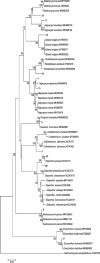Differences and biocontrol potential of haustorial endophytic fungi from Taxillus Chinensis on different host plants
- PMID: 37173641
- PMCID: PMC10182615
- DOI: 10.1186/s12866-023-02878-x
Differences and biocontrol potential of haustorial endophytic fungi from Taxillus Chinensis on different host plants
Abstract
Background: To explore the community composition and diversity of the endophytic fungi in Taxillus chinensis, samples of the parasites growing on seven different hosts, Morus alba, Prunus salicina, Phellodendron chinense, Bauhinia purpurea, Dalbergia odorifera, Diospyros kaki and Dimocarpus longan, were isolated. The strains were identified by their morphological characteristics and their internal transcribed spacer (ITS) sequences.
Results: 150 different endophytic fungi were isolated from the haustorial roots of the seven hosts with a total isolation rate of 61.24%. These endophytic fungi were found to belong to 1 phylum, 2 classes, 7 orders, 9 families, 11 genera and 8 species. Among of them, Pestalotiopsis, Neopestalotiopsis and Diaporthe were the dominant genera, accounting for 26.67, 17.33 and 31.33% of the total number of strains, respectively. Diversity and similarity analyses showed that the endophytic fungi isolated from D. longan (H'=1.60) had the highest diversity index. The highest richness indexes were found in M. alba and D. odorifera (both 2.23). The evenness index of D. longan was the highest (0.82). The similarity coefficient of D. odorifera was the most similar to D. longan and M. alba (33.33%), while the similarity coefficient of P. chinense was the lowest (7.69%) with M. alba and D. odorifera. Nine strains showed antimicrobial activities. Among them, Pestalotiopsis sp., N. parvum and H. investiens showed significant antifungal activity against three fungal phytopathogens of medicinal plants. At the same time, the crude extracts from the metabolites of the three endophytic fungi had strong inhibitory effects on the three pathogens. Pestalotiopsis sp., N. parvum and H. investiens had the strongest inhibitory effects of S. cucurbitacearum, with inhibitory rates of 100%, 100% and 81.51%, respectively. In addition, N. parvum had a strong inhibitory effect on D. glomerata and C. cassicola, with inhibitory rates of 82.35% and 72.80%, respectively.
Conclusions: These results indicate that the species composition and diversity of endophytic fungi in the branches of T. chinensis were varied in the different hosts and showed good antimicrobial potential in the control of plant pathogens.
Keywords: Biodiversity; Inhibitory activity; Phylogeny; Plant endophytes; Taxillus chinensis.
© 2023. The Author(s).
Conflict of interest statement
Not applicable.
Figures






References
-
- Wilson D, Endophyte The evolution of a term and clarification of its use and definition. Oikos. 1995;73:274–6. doi: 10.2307/3545919. - DOI
-
- Yang Q, Zou K, Chen AJ, Guo X, Liu XD, Liang YL. Endophytic fungal communities structure and variation in Ginkgo biloba leaf tissues with different ages. J Hunan Agricultural Univ (Natural Sciences) 2019;45:42–9.
Publication types
MeSH terms
Substances
Supplementary concepts
LinkOut - more resources
Full Text Sources
Miscellaneous

